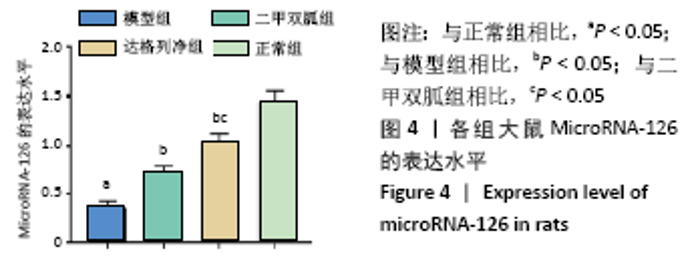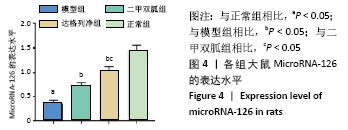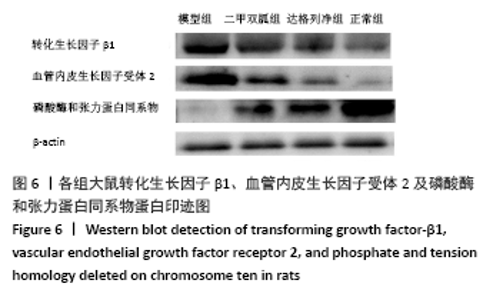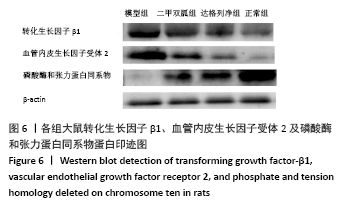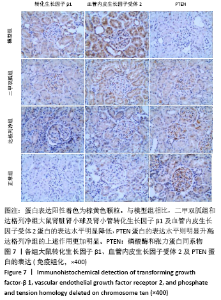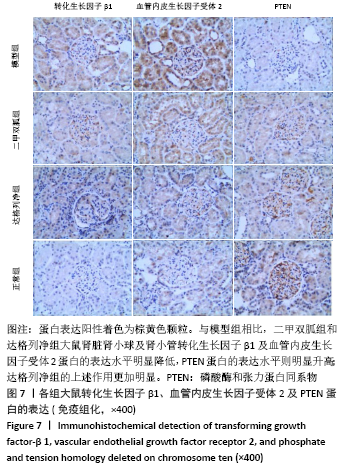Chinese Journal of Tissue Engineering Research ›› 2022, Vol. 26 ›› Issue (8): 1216-1222.doi: 10.12307/2022.226
Previous Articles Next Articles
Dapagliflozin improves renal injury in diabetic nephropathy rats
Wang Qin1, Shen Cheng2, Liao Jing1, Yang Ye1
- 1Department of Geriatrics, Second Affiliated Hospital of Xinjiang Medical University, Urumqi 830063, Xinjiang Uygur Autonomous Region, China; 2Department of Critical Care Medicine, Urumqi Friendship Hospital, Urumqi 830049, Xinjiang Uygur Autonomous Region, China
-
Received:2021-04-08Revised:2021-04-12Accepted:2021-05-18Online:2022-03-18Published:2021-11-02 -
Contact:ang Ye, Master, Attending physician, Department of Geriatrics, Second Affiliated Hospital of Xinjiang Medical University, Urumqi 830063, Xinjiang Uygur Autonomous Region, China -
About author:Wang Qin, Master, Attending physician, Department of Geriatrics, Second Affiliated Hospital of Xinjiang Medical University, Urumqi 830063, Xinjiang Uygur Autonomous Region, China -
Supported by:the Natural Science Foundation of Xinjiang Uygur Autonomous Region, No. 2020D01C192 (to YY)
CLC Number:
Cite this article
Wang Qin, Shen Cheng, Liao Jing, Yang Ye. Dapagliflozin improves renal injury in diabetic nephropathy rats[J]. Chinese Journal of Tissue Engineering Research, 2022, 26(8): 1216-1222.
share this article
Add to citation manager EndNote|Reference Manager|ProCite|BibTeX|RefWorks
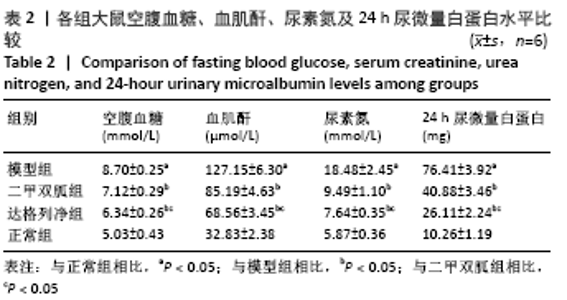
2.1 实验动物数量分析 纳入健康SPF级SD大鼠24只,随机分为2组,正常组6只,糖尿病肾病模型组18只,再将糖尿病肾病大鼠随机分为模型组、二甲双胍组、达格列净组(n=6),24只大鼠均被纳入结果分析。 2.2 各组大鼠空腹血糖、血肌酐、尿素氮及24 h尿微量白蛋白水平比较 模型组大鼠空腹血糖、血肌酐、尿素氮及24 h尿微量白蛋白水平较正常组明显升高(P < 0.05);与模型组相比,二甲双胍组和达格列净组大鼠空腹血糖、血肌酐、尿素氮及24 h尿微量白蛋白水平明显降低(P < 0.05);达格列净组大鼠空腹血糖、血肌酐、尿素氮及24 h尿微量白蛋白水平较二甲双胍组明显降低(P < 0.05),见表2。"
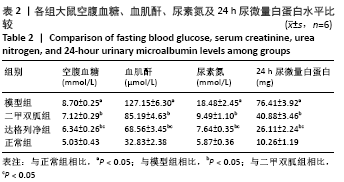
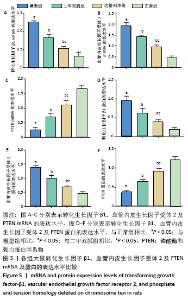
2.4.2 转化生长因子β1、血管内皮生长因子受体2及PTEN mRNA及蛋白的表达水平 模型组大鼠肾脏转化生长因子β1及血管内皮生长因子受体2 mRNA及蛋白的表达水平较正常组明显升高(P < 0.05),PTEN mRNA及蛋白的表达水平则明显降低(P < 0.05)。与模型组相比,二甲双胍组和达格列净组大鼠肾脏转化生长因子β1及血管内皮生长因子受体2 mRNA及蛋白的表达水平明显降低(P < 0.05),PTEN mRNA及蛋白的表达水平则明显升高(P < 0.05)。达格列净组大鼠肾脏转化生长因子β1及血管内皮生长因子受体2 mRNA及蛋白的表达水平较二甲双胍组明显降低(P < 0.05),而PTEN mRNA及蛋白的表达水平则明显升高(P < 0.05),见图5,6。"
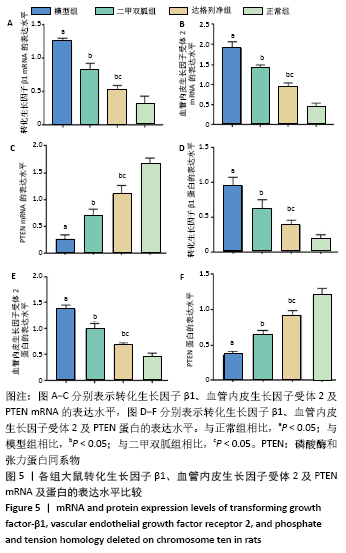
| [1] WU JX, JIA A, TAN YF, et al. Effect of Alpina oxyphylla extract on streptozotocin-induced kidney injure via regulating TGF-β1 and MyD88. BMC Complement Med Ther. 2020;20:217. [2] DESIRÉE LR, ALBERTO MC, JOSÉ LG, et al. Pathophysiological role and therapeutic implications of inflammation in diabetic nephropathy. World J Diabetes. 2012;3(1):7-18. [3] MAMDOUH A, MOHAMMED F, MARWA M, et al. Dapagliflozin attenuates early markers of diabetic nephropathy in fructose-streptozotocin-induced diabetes in rats. Biomed Pharmacother. 2019; 109:910-920. [4] WANNER C, INZUCCHI SE, LACHIN JM, et al. Empagliflozin and progressionof kidney disease in type 2 diabetes. N Engl J Med. 2016; 375:323-334. [5] 祝再然,张明,赵桂金,等. SGLT2 抑制剂对糖尿病肾病大鼠足细胞损伤及PTEN/PI3K/Akt 信号通路的影响[J]. 广东医学,2020,41(24): 2490-2494. [6] BHATT K, MI QS, DONG Z. MicroRNAs in kidneys: biogenesis, regulation, and pathophysiological roles. Am J Physiol. 2011;300(3):F602-610. [7] SUN T, LIU Y, LIU L, et al. MicroRNA-544 attenuates diabetic renal injury via suppressing glomerulosclerosis and inflammation by targeting FASN. Gene. 2020;723:143986. [8] FENG Y, JIN MY, LIU DW, et al. Correction: Proteasome subunit-alpha type-6 protein is post-transcriptionally repressed by the microRNA-4490 in diabetic nephropathy. Biosci Rep. 2019;1:39. [9] WANG S, AURORA AB, JOHNSON BA, et al. The endo-thelial-specific microRNA miR-126 governs vascular integrityand angiogenesis. Dev Cell. 2008;15:261-271. [10] GHADA AK, GHAZI AM, HALFA ABDULLA AM, et al. Decreased expression of circulating microRNA-126 in patients with type 2 diabetic nephropathy: A potential blood-based biomarker. Exp Ther Med. 2016; 12:815-822. [11] SUN F, YU PF, WANG D, et al. MicroRNA-488 regulates diabeticnephropathy via TGF-β1 pathway. Eur Rev Med Pharmacol Sci. 2019;23:4333-4340. [12] LAVOZ C, RODRIGUES-DIEZ R, ANITA PLAZA A, et al. VEGFR2 Blockade Improves Renal Damage in an Experimental Model of Type 2 Diabetic Nephropathy. J Clin Med. 2020;9:302. [13] YUAN Y, SHEN C, ZHAO SL, et al. MicroRNA-126 affects cell apoptosis, proliferation, cell cycle and modulates VEGF/TGF-β levels in pulmonary artery endothelial cells. Eur Rev Med Pharmacol Sci. 2019;23: 3058-3069. [14] LI YJ, HU QS, LI CL, et al. PTEN-induced partial epithelial-mesenchymal transition drives diabetic kidney disease. J Clin Invest. 2019;129(3):1129-1151. [15] GE R, LV YT, LI PP, et al. Upregulated microRNA-126 induces apoptosis of dental pulp stem cell via mediating PTEN-regulated Akt activation. J Clin Lab Anal. 2021;35:e23624. [16] CHEN SR, CAI WP, DAI XJ, et al. Research on miR-126 in glioma targeted regulation of PTEN/PI3K/Akt and MDM2-p53 pathways. Eur Rev Med Pharmacol Sci. 2019;23:3461-3470. [17] 章江南. 达格列净对早期 2 型糖尿病肾病临床效果及尿微量白蛋白的影响[J].北方药学,2020,17(6):8-9. [18] HATANAKA T, OGAWA D, TACHIBANA H, et al. Inhibition of SGLT2 alleviates diabetic nephropathy by suppressing high glucose‐induced oxidative stress in type 1 diabetic mice. Pharmacol. Res Perspect. 2016; 4:e00239. [19] ISHIBASHI Y, MATSUI T, YAMAGISHI S. Tofogliflozin, a highly selective inhibitor of SGLT2 blocks proinflammatory and proapoptotic effects of glucose overload on proximal tubular cells partly by suppressing oxidative stress generation. Horm Metab Res. 2016;48:191-195. [20] VJERA N, TEA O, HRVOJE R, et al. Renal Benefits of SGLT 2 Inhibitors and GLP-1Receptor Agonists: Evidence Supporting a Paradigm Shift in the Medical Management of Type 2 Diabetes. Int J Mol Sci. 2019;20:5831. [21] PAPAIT R, SERIO S, PAGIATAKIS C, et al. Histone methyltransferase G9a is required for cardiomyocyte homeostasis and hypertrophy. Circulation. 2017;136:33-34. [22] TOMASETTI M, NOCCHI L, STAFFOLANI S, et al. MicroRNA-126 suppresses mesothelioma malignancy by targeting IRs1 and interfering with the mitochondrial function. Antioxid Redox Signal. 2014;21(15):2109-2125. [23] 崇显瑾, 余青原, 杨历新. 2 型糖尿病肾病患者血清中 miR-126 和 sVCAM-1 的表达关系及意义[J]. 河北医药,2019,41(3):334-342. [24] HU Z, WONG KW, ZHAO HM, et al. Sendai virus mucosal vaccination establishes lung-resident memory CD8 T cell immunity and boosts BCG-Primed protection against TB in mice. Mol Ther J Am Soc Gene Ther. 2017;25:1222-1233. [25] 郭晓莉, 陈艳, 马卫国.等. 血液循环中 miR-126 作为标志物对 2 型糖尿病肾脏疾病患者诊断的临床意义[J]. 临床肾脏病杂志,2017, 17(6):361-365. [26] JAMES V, PAUL H, MATTHEW S, et al. Anti–TGF-b1 Antibody Therapy in Patients with Diabetic Nephropathy. J Am Soc Nephrol. 2017;28: 953-962. [27] JIN J, CHAO PENG C, WU SZ, et al. Blocking VEGF/Caveolin-1 signaling contributes to renal protection of fasudil in streptozotocin-induced diabetic rats. Acta Pharmacologica Sinica. 2015;36:831-840. [28] YU SJ, ZHAO HR, YANG WJ, et al. The Alcohol Extract of Coreopsis tinctoria Nutt Ameliorates Diabetes and Diabetic Nephropathy in db/db Mice through miR-192/miR-200b and PTEN/AKT and ZEB2/ECM Pathways. BioMed Res Int. 2019;2019:5280514. [29] CHEN KH, DAI HZ, YUAN JJ, et al. Optineurin-mediated mitophagy protects renal tubular epithelial cells against accelerated senescence in diabetic nephropathy. Cell Death Dis. 2018;9:105. [30] MAHMOUDI RM, MAHMOUDI RN, MIRDAMADI Y. Expression of TGF-beta3 in isolated fibroblasts from foreskin. Rep Biochem Mol Biol. 2015;3:76-81. [31] DING JN, WANG X, CHEN B, et al. Exosomes Derived from Human Bone Marrow Mesenchymal Stem Cells Stimulated by Deferoxamine Accelerate Cutaneous Wound Healing by Promoting Angiogenesis. BioMed Res Int. 2019;2019:9742765. |
| [1] | Wu Cong, Jia Quanzhong, Liu Lun. Relationship between transforming growth factor beta1 expression and chondrocyte migration in adult articular cartilage after fragmentation [J]. Chinese Journal of Tissue Engineering Research, 2022, 26(8): 1167-1172. |
| [2] | Yang Zhiwei, Liu Junchang, Gao Xiaolin, Jiang Taimao. Relationship between tacrolimus metabolic rate and early BK virus infection after kidney transplantation [J]. Chinese Journal of Tissue Engineering Research, 2022, 26(5): 712-716. |
| [3] | Xu Weijun, Hu Xiangdan, Yu Dongqing. First-trimester human decidual mesenchymal stem cells combined with tanshinone IIA in the treatment of intrauterine adhesions in rats [J]. Chinese Journal of Tissue Engineering Research, 2022, 26(25): 3986-3992. |
| [4] | He Xingpeng, Zheng Liqin, Li Pengfei, Yue Guiyang, Li Zhihong, Wu Minhui, Lin Ziling. Differences of trabecular microstructure and bone metabolism in two types of kidney-deficiency ovariectomized rats [J]. Chinese Journal of Tissue Engineering Research, 2022, 26(23): 3768-3772. |
| [5] | Geng Yuanwen, Lin Qinqin, Li Ruoming, Tang Shaokai, Wang Baihui, Tian Zhenjun. A single bout of exhaustive exercise induces renal NOD-like receptor protein 3 inflammasome expression in rats [J]. Chinese Journal of Tissue Engineering Research, 2022, 26(2): 190-196. |
| [6] | Li Wanhai, Dong Yuhang, Shi Chao, Jiang Yiyao, Liu Ge, Diao Wenjie, Wu Zhen. Ligustrazine furoxan complex protects against renal ischemia-reperfusion injury in mice [J]. Chinese Journal of Tissue Engineering Research, 2022, 26(2): 205-210. |
| [7] | Chen Yuting, He Feiming, Xiang Wei, Wang Chao, Cao Weiwei, Wang Weishan, Liu Wei . Effects of transforming growth factor beta1 and Ras homolog gene family member A on cell morphology and cytoskeleton during chondrocyte differentiation [J]. Chinese Journal of Tissue Engineering Research, 2022, 26(14): 2144-2149. |
| [8] | Li Min, Yu Yang, Cheng Jiyan. Mechanism of paeoniflorin on bone marrow mesenchymal stem cells intervened by lipopolysaccharide [J]. Chinese Journal of Tissue Engineering Research, 2022, 26(13): 2000-2005. |
| [9] | Han Jie, Ren Guowu, Mo Jian, Zhang Xiaoyun, Wen Shuaibo, Wu Yukun. Chinese herbal prescriptions for tonifying kidney and promoting blood circulation in the intervention of steroid-induced avascular necrosis of the femoral head: relevant signal pathways and targets [J]. Chinese Journal of Tissue Engineering Research, 2022, 26(11): 1758-1764. |
| [10] | Xu Xueling, Liu Jun, Yang Aihua, Wang Huifang, Guo Dandan, Liu Xuemei, Xu Yan. High glucose induces high expression of stem cell factor in human renal tubular epithelial cells [J]. Chinese Journal of Tissue Engineering Research, 2022, 26(1): 96-100. |
| [11] | Wang Shuyun, Xie Junhui, Yu Xuefeng. Effect and mechanism of mesenchymal stem cells in the treatment of diabetic nephropathy [J]. Chinese Journal of Tissue Engineering Research, 2022, 26(1): 148-152. |
| [12] | Zeng Zhen, Hu Jingwei, Li Xuan, Tang Linmei, Huang Zhiqiang, Li Mingxing. Quantitative analysis of renal blood flow perfusion using contrast-enhanced ultrasound in rats with hemorrhagic shock during resuscitation [J]. Chinese Journal of Tissue Engineering Research, 2021, 25(8): 1201-1206. |
| [13] | Jiang Xin, Qiao Liangwei, Sun Dong, Li Ming, Fang Jun, Qu Qingshan. Expression of long chain non-coding RNA PGM5-AS1 in serum of renal transplant patients and its regulation of human glomerular endothelial cells [J]. Chinese Journal of Tissue Engineering Research, 2021, 25(5): 741-745. |
| [14] | Nie Huijuan, Huang Zhichun. The role of Hedgehog signaling pathway in transforming growth factor beta1-induced myofibroblast transdifferentiation [J]. Chinese Journal of Tissue Engineering Research, 2021, 25(5): 754-760. |
| [15] | Cui Tianning, Liu Tao, Xiao Xiangyang, Wang Shuai, Zhang Nini, Huang Guilin. Effect of urinary-derived stem cells and extracellular vesicles in tissue damage repair [J]. Chinese Journal of Tissue Engineering Research, 2021, 25(31): 5046-5052. |
| Viewed | ||||||
|
Full text |
|
|||||
|
Abstract |
|
|||||






